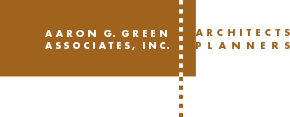Over 200 housing units were completed from designs and plans prepared by Aaron G. Green Associates, as well as administration of their construction contract.
The Master Plan received the Honor Award from HUD for Urban Design Concept. From HUD's news release, "The phased residential upgrading of a low income district represents a thorough and aggressive approach to solving the most critical problem in city design."
Design Objectives: Develop a spirited, colorful, humane, informal, and inviting architectural vocabulary of domestic scale with which the occupants could feel comfortable and proud of their planning accomplishments.
Negate by design the scale and institutional character normally associated with mass housing and expressly distasteful to the participants.
Develop sensitive relationships of roof forms and site as well as exploit interest of topographical features by a variety of entrance levels, bridges and ramps.
Landscaped open spaces were developed to be usable for recreation and social activities in addition to providing visual relief.
Design and engineering concepts sought to exploit the varying topography in order to create interest, identity and articulation to the separate architectural design of the villages, separate functions and vehicular and pedestrian circulation.

